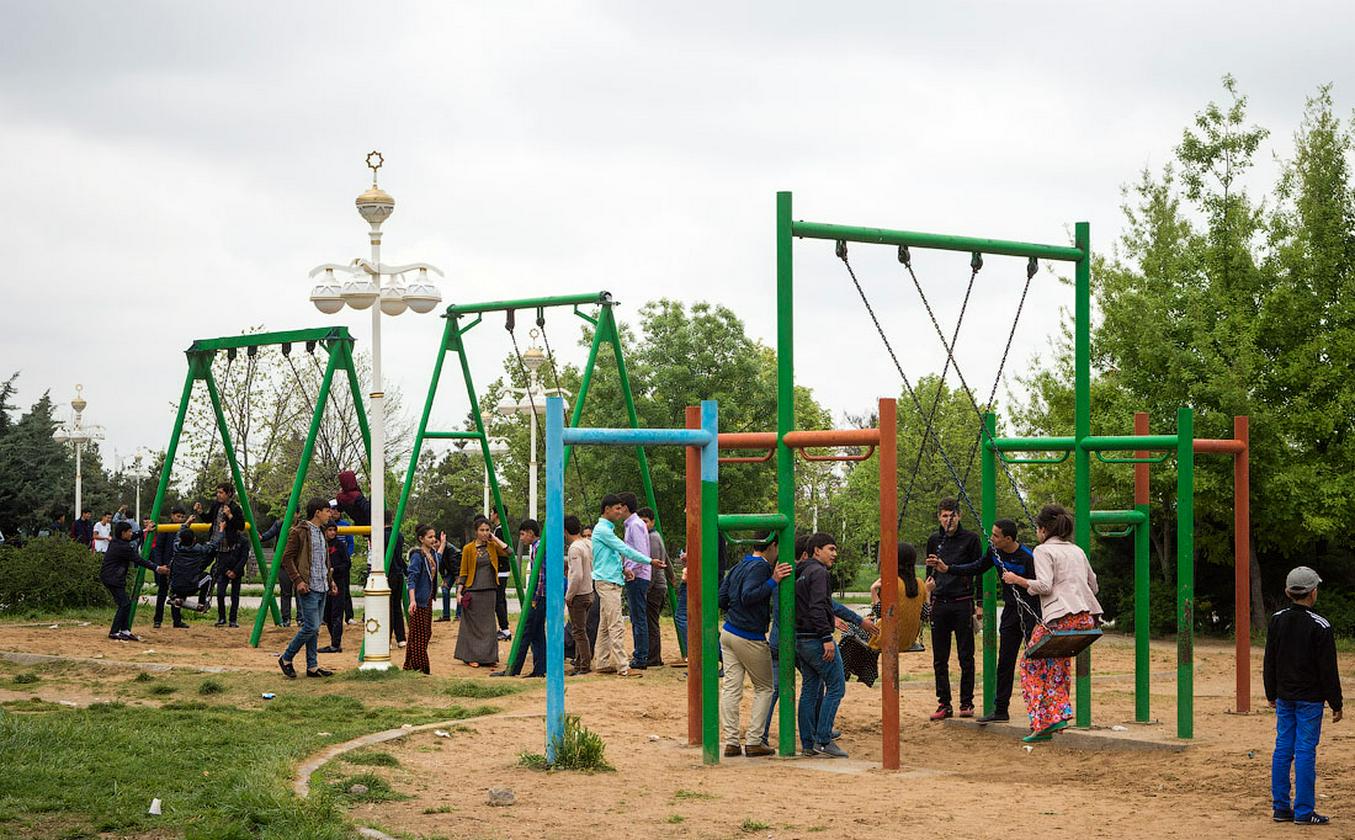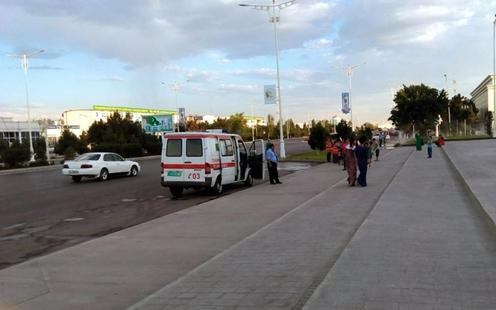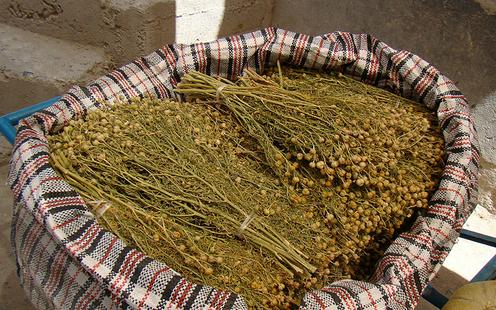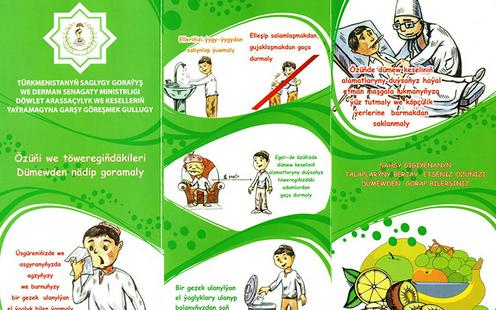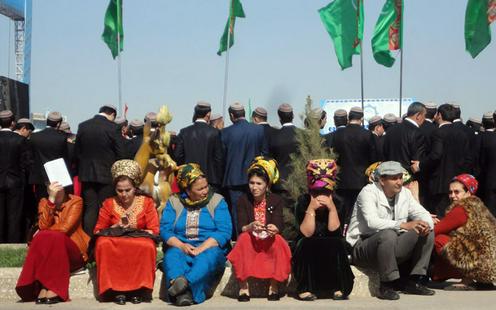At present, there are fewer than 20 countries around the world still yet to be affected by COVID-19. More than half of them are island states in the Pacific Ocean, where for obvious reasons it has been hard for the virus to penetrate. In Europe and the Americas, not a single coronavirus-free country remains. In Africa, it is only the island state of the Comoros and Lesotho – a landlocked enclave within the territory of South Africa – that are exempt. In Asia, the coronavirus has yet to be reported in North Korea, South Ossetia (recognised by the Russian Federation as independent from Georgia – translator’s note), Tajikistan and Turkmenistan. But doubts remain – are these countries really still free of COVID-19? On 14 April, independent journalists once again reported cases of infections in Turkmenistan, and the material they published to back up their story appears highly convincing.
In dubious company
A simple glance at the names of the other Eurasian states free of the virus raises doubt. South Ossetia’s independence from Georgia has only been recognised by six countries around the world. If we follow Russia, Venezuela, Nicaragua, Nauru, Syria and Tuvalu and accept South Ossetia as an independent state, then we are talking about a country with a surface area of 3,900 square kilometres and a population of 53,500. If this tiny corner of the world has so far escaped infection then that is all well and good. But it is hardly a surprise.
As for North Korea, Tajikistan and Turkmenistan, these are countries that are regularly criticised for their closed, authoritarian rule. Here we are simply left to guess: has COVID-19 really not reached them because what the rest of the world calls a lockdown is in these countries something akin to a way of life, or are the authorities deliberately choosing to conceal information about infections?
It seems safe to venture that the real situation is probably somewhere in between. It is indeed very likely that the closed nature of these states has allowed them to avoid a significant spread of infections so far. At the same time, if, for instance, the number of people dying from “pneumonia” or “old age” in Turkmenistan suddenly increases, such statistics are unlikely to be made readily available to international observers and the independent press. Based outside of the country, yet drawing on information from anonymous sources spread all over the closed republic, independent Turkmen media outlets are hardly likely to have missed the large number of deaths that would accompany a truly significant COVID-19 outbreak. Sick people in every family, overflowing intensive care wards and mass graves – in our digital age such things are impossible to hide even behind the most rigid of iron curtains.
But if the infected “only” number in the hundreds, and the dead in the dozens...then it is entirely possible that no one will ever find out. This is already the case in Turkmenistan with respect to HIV. According to official statistics, the country has only ever had two HIV patients in its whole history. Of course, independent media outlets publish reports claiming that the real number of the HIV-positive in Turkmenistan is far higher. They are simply hospitalised under false diagnoses (such as “food poisoning” or “unknown dangerous infection”) or under the code name “form 50”. Sporadic leaks of information, however, are not statistics. Researchers are simply left to note that almost nothing is known about the situation with HIV in Turkmenistan.
A challenge for state propaganda
The COVID-19 pandemic poses a complex and entirely new kind of problem for governments all around the world. This is the first time that such a relatively mild infection has spread around the globe with such devastating speed, threatening to bring healthcare systems swiftly to the point of collapse. Never before have governments been forced, in order to avoid such a collapse, to introduce such strict quarantine and lockdown measures, in effect knowingly crippling their own countries’ economies. This has placed not only medics, economists and security officials in a quandary, but also PR specialists. How do they communicate to the public what is going on? What position should they adopt? What should they ask the public to do in these difficult times and how?
The task has certainly not been easy for Turkmenistan’s state-controlled media. In fact, it seems as if they are still yet to arrive at a definitive decision on how to talk about COVID-19 and what exactly to say. Or even whether they should be talking about it at all.
Despite widespread reports in the international press to the contrary, from the very start of the pandemic the Turkmen press has not sought to cover up the existence of the new virus entirely. Initially, the pro-government media, devoting a certain measure of attention to international stories, frequently wrote about COVID-19 as one of a plethora of ills that befall those unfortunate enough to be born outside of the flourishing country of Turkmenistan (or those stupid enough to leave it). At the same time, both the pro-government and even the official state media began to carefully advise the public that it might not be bad idea to be on their guard against all kinds of infections. Not COVID-19 of course – perish the thought! But simply various types of respiratory infections. There are so many of them going around after all...
Among the recommended sanitary measures were some rather exotic suggestions – like fumigating homes and buildings with harmala smoke. For the residents of Turkmenistan such recommendations are nothing new. The antiviral properties of this local herb have long been touted by the country’s president Gurbanguly Berdymukhammedov (the Arkadag, or “Protector”) personally, who happens to be the author of a multivolume work on medicinal herbs. As a result, clouds of harmala smoke have quite literally descended over the whole of Turkmenistan, and the cost of the herb on local markets has skyrocketed. Some purchased the “magic” herb in order to demonstrate their loyalty to the authorities, others because they reckoned that if school headmasters and hospital managers were busy mass-fumigating their establishments with herbal fumes on the advice of the president himself, then there must be some logic to their actions...
In some places, popular wisdom went even further than the official recommendation. People started trying to protect themselves from the coronavirus by drinking a broth made from sheep’s head and feet. Following this, the price of these offal meats too immediately shot up.
Preventive measures are all very well, but placing too much emphasis on COVID-19 inside Turkmenistan is still not advisable. As in so many other matters, the decisions of the Turkmen authorities can depend on a plethora of different factors – the convictions of a particular official, what he happened to hear at a meeting the day before and what he understood from it... Perhaps they will punish you for refusing to chip in to buy harmala for the fumigation of the local government office where you work, perhaps for wearing a medical mask, on the grounds that you are thereby “inciting panic”.
More complex than a prohibition
Trawling through independent media reports, one gets the impression that even state officials themselves do not know quite what to make of the pandemic. For example, at the start of February, officials in Ashgabat started distributing booklets in which the coronavirus was named directly. In the middle of March, however, a new edition of the booklet removed all mention of the “dangerous” word. This led the independent press to assume that the word “coronavirus” itself had been banned. By 31 March, this information reached press freedom NGO Reporters Without Borders and from there quickly spread to a vast number of foreign media outlets. Thus was born yet another legend about Turkmenistan.
Unfortunately for the Turkmen authorities, the timing lined up perfectly for the first of April, and one independent news site thought it would be funny to publish a fake statement by the Turkmen foreign ministry. The parody press release declared that “In its unanimous desire to support the efforts of our Dear President Gurbanguly Berdymukhamedov to secure the health and spiritual and physical renaissance of the Turkmen nation, the citizens of Turkmenistan have willingly renounced the use of the word ‘coronavirus’.” Alas, the time was not entirely ideal for jokes and few people saw the article for what it was, further adding to the confusion on the Turkmen authorities’ position.
State-run and pro-government media outlets did not publish any official statement in reply and in fact gave no overt sign that they had even noticed their foreign colleagues’ critique. However, they did start to become noticeably more active in employing the supposedly forbidden word. On 6 April, for instance, the news website Orient, which on 30 March (before the publication by Reporters Without Borders) had rather weakly attributed the absence of the coronavirus in Turkmenistan to the magic properties of harmala fumes, felt emboldened to proffer a political analysis of sorts. The article directly stated that Turkmenistan was one of 22 countries in which no cases of COVID-19 had been established (citing the rather questionable source of the British tabloid The Daily Star to argue that timely border closures had prevented the spread of the virus – Editor’s note). The news outlet was apparently not embarrassed to announce that this list of countries included North Korea, comparisons with which traditionally abound in critiques of Turkmenistan.
On the subject of Turkmenistan itself, the short article kept things very brief: “Despite the fact that no cases of coronavirus infection have been recorded in the country, the government is increasing its stocks of medicines and disinfectants both through domestic production and import”. In other words, the pro-government media was allowed not just to mention the coronavirus, but even to theoretically entertain the possibility that the infection could make an appearance inside the country.
Two days later, however, after independent media outlets reported that plans for a mass bike ride led by the president had been ditched in favour of separate events for Berdymukhamedov and for the public, Orient was unable to hold itself back from gloating. The event had still gone ahead as scheduled, the news outlet emphasised, adding: “Against the backdrop of harsh lockdown measures in other countries, here we could allow ourselves this luxury – while the new coronavirus epidemic rages all over the planet, not a single case of COVID-19 has been established in Turkmenistan”. “Swiftly implemented preventive measures have worked” in the country, the article claimed.
But what measures exactly? On this subject Orient and other pro-government outlets have remained almost entirely silent. Only from independent sources has it been possible to find out that international flights into the country were first redirected from Ashgabat to Turkmenabad, and then totally suspended. There, in the Lebap velayat (region), of which Turkmenabad is the administrative centre, quarantine camps were hastily constructed for arrivals from abroad. Restrictions on movement inside the country were also introduced – though this sort of thing happens quite regularly in Turkmenistan even in the absence of a viral pandemic. Why, though, when these kinds of measures are being applied for noble reasons by countries all over the world, does Turkmen state media continue to pass over them in stubborn silence? Perhaps simply out of habit.
Invite no more than 200
Another issue is that of large-scale events, both public and private. The question first arose ahead of Nowruz – the traditional celebration to welcome in spring. In almost all countries where the event is celebrated, large-scale public celebrations were cancelled. Journalists reported that in Turkmenistan’s “quarantine” velayat of Lebap, one official had made so bold as to suggest skipping celebrations for this year. The deputy hyakim for culture, Gurbandury Saryev, however, responded with a warning that, in future, such statements would be dealt with as attempts to sabotage events of national importance. With all that such a charge might entail...
Ultimately, celebrations in honour of Nowruz were indeed held all around the country. Incidentally, this did not stop a number of security service officials in the Lebap region from resorting to the principle of “every man for himself” and moving their families to live in tents on the territory of the Repetek nature reserve to keep them safe from possible infection.
One might think that the Turkmen political system would allow the authorities to quickly and efficiently shut down even private large-scale gatherings. Yet it would appear that those in charge are unwilling to apply the repressive apparatus of state for the benefit of their citizens. Only on 8 April was it reported in the independent press that a limit had been set to weddings, birthday celebrations and other similar events...of 200 guests. It seems safe to say that this had little impact on people’s lives. From now on, families would simply have to make do with quiet and unpretentious banquets for no more than 199 people.
The financial situation of the majority of the population of Turkmenistan, however, meant that they were rather less concerned with how to organise a party than with how to obtain food for their families even just one day at a time. Here of course, everything revolves around another popular “public event” in Turkmenistan – standing in queues. Those without the means to buy from private traders are forced to “hunt” for shortage goods at cheaper prices in state-run stores. To judge by reports in the independent media, the authorities seem to be making little effort to do anything about this particular epidemiological risk factor. In fact, at the start of April, an extremely rare event in Turkmenistan took place as residents of the suburbs of Mary staged a protest against food shortages, and officials were forced to disperse the demonstrators by handing out packets of flour.
A few days later, police attention was reportedly drawn to excessively compact queuing outside a store in Ashgabat – not, however, out of concern for COVID-19. Women in the queue were angry that men were pushing up too closely to them, while men were worried that more chivalrous behaviour might mean losing their places in line. Ultimately, police solved the problem by creating two queues, one for women and one for men, but no mention was made of 1.5-2m distances, masks and gloves or anything of the like.
Things start to heat up
State media are doing their utmost to demonstrate that in Turkmenistan, unlike every other country in the world, COVID-19 is not the only, nor even the main news story of the day. Virus shmirus, radiant Turkmen citizens are busily preparing to celebrate Akhal-Teke Horse Day, admiring the reconstructed cranium of an ancient elephant species in an Ashgabat museum, consulting lawyers for advice on entrepreneurship, and so on and so on...
Nevertheless, reality is knocking ever more insistently at the door of the crystal fortress. Almost from the very first days of the global pandemic, the independent Turkmen media has been citing reports by anonymous sources about confirmed infections inside Turkmenistan. Initially, these reports did not seem especially convincing. Over time, however, the “critical mass” of information has accumulated, as one outlet after another has acquired anonymous sources in the infamous quarantine camps... Finally on 14 April, Chronicles of Turkmenistan published a detailed notice claiming that seven people with positive test results for COVID-19 were being held in a separate tent in the camp opposite the hippodrome in Turkmenabad.
Chronicles of Turkmenistan’s video of the quarantine tent
On 15 April, Chronicles of Turkmenistan also reported that from 10 April the authorities in Turkmenabad had decided to introduce a total ban on weddings and other family celebrations after all. According to the website’s sources, however, one national security official violated the ban on the very same day, holding a sumptuous wedding celebration after leading a noisy procession through town.
Azatlyk’s journalists, meanwhile, wrote that mass coronavirus testing was being carried out both in schools in the Lebap velayat (again) and in educational institutions in the capital Ashgabat. On 15 April, Chronicles of Turkmenistan’s sources reported that pupils at schools in Ashgabat were being vaccinated – for what exactly doctors would not say. Vaccines for COVID-19 are currently still in development, but Chronicles’ sources had stated the previous day that the seven infected individuals in the quarantine camp were being treated with vaccines for the H1N1 swine flu.
The pro-government Orient then acknowledged that medical examinations were being carried out in Turkmen schools. It mentioned, moreover, that this was simply the start of a wider campaign of medical check-ups that was to encompass the entire population. Has the government decided to start testing Turkmen citizens for COVID-19 after all, without wanting to enter into the tedious and frightening details?
Equal partners
So the current situation with COVID-19 in Turkmenistan is probably that a small number of infected individuals are being housed in strictly isolated camps. Outside of the camps, however, the authorities are doing all they can to maintain the illusion of wellbeing and bliss. For this reason, if the virus does manage to “break out” of its current compound, it is likely to spread rapidly among the population, thanks to the national celebrations that are still being staged, to large-scale private events that are still not subject to full bans for all, to the country’s notorious queues and to the continued operation of schools and workplaces. And the new virus will be fought with a vaccine created for a different infection...
The hope remains that help will come from abroad. But, first of all, traditional donor countries are precisely those countries currently hardest hit by the COVID-19 pandemic. And secondly, the Turkmen authorities have already proven themselves rather prickly and difficult to deal with on this score. On 6 April, the US embassy in Turkmenistan allocated $920,000 to the country for the fight against the coronavirus. In the press release announcing the move, the embassy wrote that “the United States has invested approximately $21 million in healthcare, and more than $201 million in total assistance to Turkmenistan over the past 20 years.” The pro-government TurkmenPortal was careless enough to republish the press release on its website.
Clearly, the Americans’ position had offended someone at the top. The story on TurkmenPortal was removed immediately and the foreign ministry of Turkmenistan issued an angry rejoinder, asserting “that the economic cooperation between Turkmenistan and the USA is implemented on the basis of mutual benefit and equal partnership”. Claims that Turkmenistan had received US economic aid were described by the foreign ministry as “untrue”.
The US embassy reacted with restraint, stating merely that “the United States is proud of its partnership with Turkmenistan in a range of fields over more than 25 years”. Yet one can only guess what discussions had gone on at the embassy behind the scenes. It is hardly likely that many states and international organisations, weighing up who to help in the peak of an epidemic, will give preference to such a prickly customer. Few will be prepared to allocate state funds, medical supplies and equipment and to fly in doctors, all the while desperately attempting not to offend a narcissistic president.
The current COVID-19 pandemic has provided a huge and unexpected test for countries all over the globe. At the start of December last year, as the first coronavirus infections were taking place in China, no one imagined that by the spring of 2020, expressions such as “lockdown”, “curfew” and “permission slip” to leave home would become common phrases for a large part of the world’s population. The reactions of different governments and peoples to the current crisis can reveal a great deal about a country and its political structure. In the case of Turkmenistan, a source of fascination to researchers even before the pandemic, watching how events pan out will be doubly interesting.
Tatyana Zverintseva
Translated and adapted by Nick L.
-
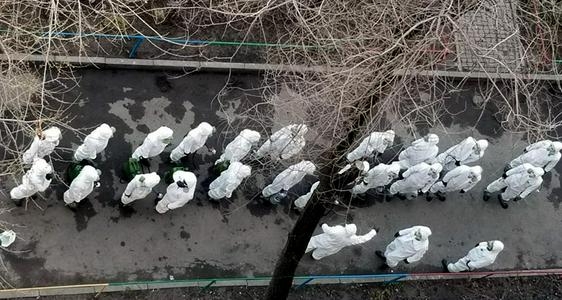 01 April01.04Central Asia in lockdownIt’s been a busy week in COVID-19’s Central Asia. Here’s a quick summary
01 April01.04Central Asia in lockdownIt’s been a busy week in COVID-19’s Central Asia. Here’s a quick summary -
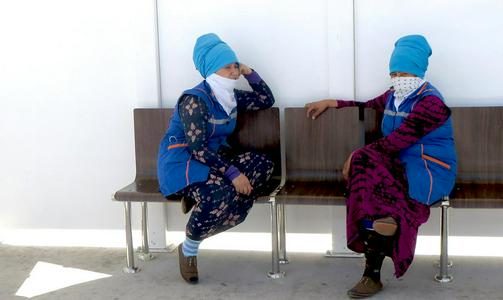 26 March26.03Lung X-rays for travel, herbal fumes and a healthy dose of silenceHow Turkmenistan is fighting an officially non-existent epidemic
26 March26.03Lung X-rays for travel, herbal fumes and a healthy dose of silenceHow Turkmenistan is fighting an officially non-existent epidemic -
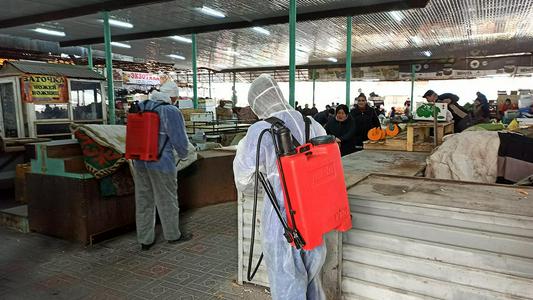 19 March19.03Border closures, litigation against God in Kyrgyzstan and a lockdown in KazakhstanHow the coronavirus is being fought in Central Asia
19 March19.03Border closures, litigation against God in Kyrgyzstan and a lockdown in KazakhstanHow the coronavirus is being fought in Central Asia -
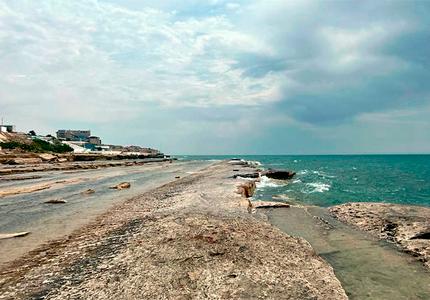 30 September30.09When Sea Becomes Fact of the PastWhy Tokayev Is Concerned About the Health of the World’s Largest Enclosed Body of Water
30 September30.09When Sea Becomes Fact of the PastWhy Tokayev Is Concerned About the Health of the World’s Largest Enclosed Body of Water -
 17 September17.09Risky PartnershipWhy Dealing with China Is Harder Than It Seems at First Glance
17 September17.09Risky PartnershipWhy Dealing with China Is Harder Than It Seems at First Glance -
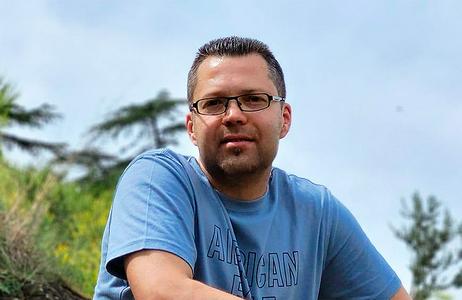 05 August05.08How Turkmenistan Lost Its Freedom of SpeechRuslan Myatiev discusses the past and present of censorship in the country
05 August05.08How Turkmenistan Lost Its Freedom of SpeechRuslan Myatiev discusses the past and present of censorship in the country
